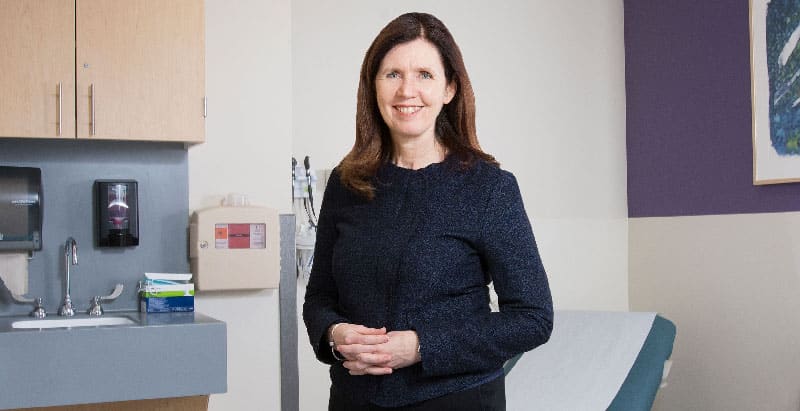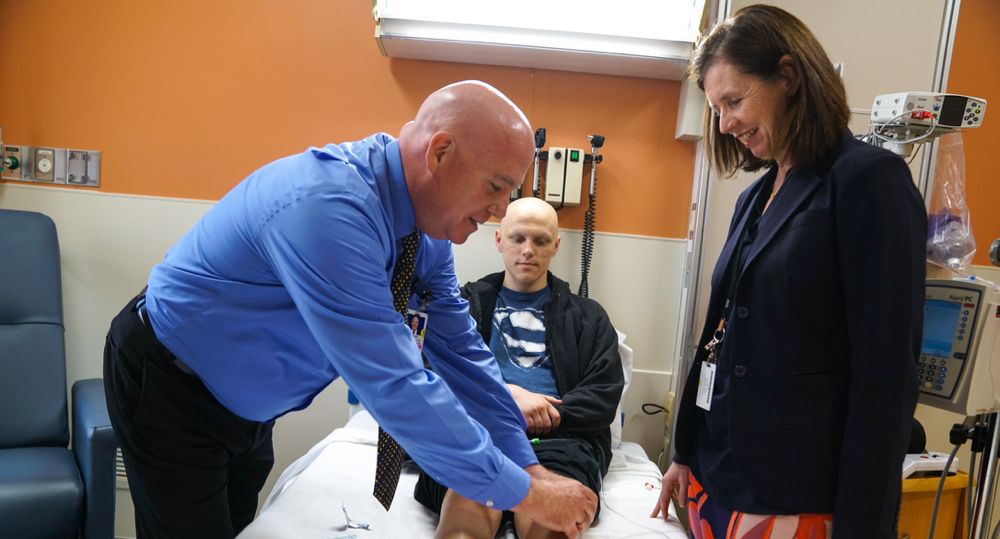“Adolescents and young adult patients need advocates to help make sure they’re able to experience improvements in care just like everyone else.”
 Kara Kelly, MD is a pediatric oncologist, Chair of Roswell Park Oishei Children’s Cancer and Blood Disorders Program, and a member of the LRF Scientific Advisory Board (SAB)
Kara Kelly, MD is a pediatric oncologist, Chair of Roswell Park Oishei Children’s Cancer and Blood Disorders Program, and a member of the LRF Scientific Advisory Board (SAB)
Lymphoma is a disease that does not discriminate. It impacts both young and old with equal intensity. It does not show preference to the elderly or otherwise infirmed and it is gender-neutral. So, when Kara Kelly, MD, an oncologist and researcher at Roswell Park Comprehensive Cancer Center, decided to go into the field of pediatric oncology, she was fulfilling an ongoing need within the field of cancer research and care.
Each year, nearly 70,000 adolescents and young adults (AYA) are diagnosed with cancer; and lymphoma, the most common type of blood cancer, accounts for nearly 1 in 5 cancer diagnoses among young people. Since this is a historically underserved population, Dr. Kelly is working tirelessly to ensure that AYA patients have advocates within the lymphoma community.
FOCUSING ON YOUNG ADULTS
While attending medical school at the University at Buffalo, Dr. Kelly participated in a pediatric rotation that sparked her interest in working with younger patients. She was excited at the prospect of making an impact on the lives of children that would, in essence, change their lives forever. “I really liked the ability to work with patients and their entire families throughout their journey, and the pediatric field is a rather supportive one, so I enjoyed working in that environment,” says Dr. Kelly, who is also Chair of the Roswell Park Oishei Children’s Cancer and Blood Disorders Program.
Dr. Kelly thought she would pursue a career in general pediatrics, but as she began to learn more about the field, she realized if her patients’ cases became complicated, she would need to refer them to sub-specialists to continue their care. “I really liked taking care of those more complex patients,” she says. “One of the great things about pediatric oncology is that you get to take care of patients, see them through their care, and learn from them to improve treatments for people in the future.”
“One of the great things about pediatric oncology is that you get to take care of patients, see them through their care, and learn from them to improve treatments for people in the future.”
After deciding to pursue a career in pediatric oncology, Dr. Kelly completed her residency and fellowship at the Children’s Hospital of Philadelphia. During her residency, she worked with an international leader in pediatric lymphoma who exposed her to the field of hematological malignancies and research. “I remember being intrigued by the research side of the field,” she recalls. “We, unfortunately, can’t save everyone, but the fact that I could contribute to our collective knowledge to hopefully cure more patients was really attractive to me.”
Dr. Kelly took her first faculty position at Columbia University Medical Center. Early on in her career, Dr. Kelly’s mentor at Columbia gave her an opportunity to lead a trial on Hodgkin lymphoma (HL) through the Children’s Oncology Group (COG). The study tested a moderate dose-intensive treatment regimen, BEACOPP (bleomycin, etoposide, doxorubicin, cyclophosphamide, vincristine, procarbazine and prednisone), for adolescents and young adults (AYA) with advanced-stage disease.
The treatment regimen had a disease-free survival rate of 94 percent and an overall survival rate of 97 percent — an exciting step forward in Dr. Kelly’s career. “That was a pivotal moment for me,” she says. “It got me excited to work in the field of lymphoma and proved that what I was doing directly benefited patients.”
UNDERSTANDING THE UNIQUE NEEDS OF THE AYA COMMUNITY
As she continued in the field of AYA oncology, Dr. Kelly discovered that treating younger patients came along with unique medical and psychosocial needs that impacted their care. The National Cancer Institute (NCI) defines the adolescent and young adult cohort as individuals between the ages of 15 and 39. Due to the complexity and disparity of this age group, Dr. Kelly says there are many factors to consider when building treatment plans for AYAs. Factors such as body image, long-term side effects and fertility make it even more challenging for physicians to put together treatment plans for AYA patients. “There is a multitude of factors that impact this age group, and therefore an optimal treatment for AYA patients, particularly with lymphomas, has yet to be identified,” says Dr. Kelly.
“There is a multitude of factors that impact this age group, and therefore an optimal treatment for AYA’s, particularly with lymphomas, has yet to
be identified.”
Since youth and maturity levels of AYAs have significant effects on their ability to manage their diagnosis and treatment, Dr. Kelly noticed that many younger patients struggle with adhering to treatment and following through with their care plans. This is especially true of those in the 15-30 age range. While Dr. Kelly recognizes that this could be due to the transitional stage that many patients in this age group are experiencing, she also believes that increased research and advocacy could help to address these needs. “We need to bring attention to this group and make people aware of some of the challenges that they face and some potential solutions to be able to help move things forward,” says Dr. Kelly.
As a clinician and researcher, Dr. Kelly found that while outcomes for the adult and pediatric cancer populations were improving, outcomes for AYAs were not. “The adolescents and young adults are a group that’s been lost in that transition between pediatric and adult care,” she says. “They need advocates to help make sure they’re able to experience improvements in care just like everyone else.”
 Dr. Kelly with a colleague Douglas McDaniel, DACM, Dipl. Ac. (NCCAOM), L.Ac., treating a patient at Roswell Park Comprehensive Cancer Center
Dr. Kelly with a colleague Douglas McDaniel, DACM, Dipl. Ac. (NCCAOM), L.Ac., treating a patient at Roswell Park Comprehensive Cancer Center
Dr. Kelly attributes gaps in improvements to a variety of unanswered questions about AYAs including, understanding the biology of different cancers, age-appropriate care delivery, and adjusting outreach and care plans for this demographic. Dr. Kelly noted that while great strides have been made in caring for AYAs, clinicians and scientists are still at the “tip of the iceberg” from a biological and research perspective. Dr. Kelly believes that greater emphasis and investment in AYA research would allow them to have a much broader understanding of both the disease as well as the psychological and social impact on the patient.
WORKING COLLABORATIVELY TOWARDS ONE GOAL
Dr. Kelly attributes much of the recent successes in adolescent and young adult research to collaborations between the pediatric and adult oncology communities. She says that many of her collaborative work is a result of her involvement with the Lymphoma Research Foundation (LRF), which has advocated for an increased focus on AYA-specific research like hers. Due to her ability to network with her colleagues, Dr. Kelly helped to develop the first collaborative clinical trial by the National Cancer Institute for Hodgkin lymphoma. “This trial was the first time that the pediatric groups and adult groups sat down together and came up with a design that was appropriate for the adolescent young adult age group,” says Dr. Kelly.
Dr. Kelly believes that increased collaboration between the pediatric and adult oncology fields will help to bring attention to adolescent and young adults and improve the care that is delivered to them. To facilitate continued conversations about AYAs, Dr. Kelly, a member of LRF’s Scientific Advisory Board (SAB), helped LRF establish its first-ever AYA Lymphoma Consortium as part of its AYA initiative Erase Lymphoma. The goal of this consortium is to convene multi-industry experts to identify and address what is needed for adolescent and young adult lymphoma patients regarding research, education and advocacy. “I help to bring experts together from many areas to hopefully reduce our tendency to work in silos,” she says. “We need to keep AYA lymphoma at the forefront so that we can ensure improvements in the future.”
The LRF AYA Lymphoma Consortium hosted its inaugural conference in 2019, drawing many attendees from the pediatric and medical oncology fields, researchers, the Food and Drug Administration (FDA), and the pharmaceutical industry – groups that rarely get the opportunity to work together, according to Dr. Kelly. She says that allowing these professionals to step out of their normal work helps to bring new ideas forward and accelerate the pace of research.
A BRIGHTER FUTURE FOR YOUNG ADULTS
While Dr. Kelly feels there has been much progress in adolescent and young adult lymphoma over the past decade, she still feels that there is more to be done. Dr. Kelly hopes that increased research and collaboration will continue to improve survival rates, and more importantly, maintain their quality of life post-cancer. “Our therapies still have a lot of side effects both in the short term, and potentially the long term,” she says. “I just want to be able to do better for my patients — that is what’s driving me.”
While many challenges still exist for AYAs with lymphoma, Dr. Kelly feels there are many reasons to be hopeful, including LRF’s very patient-centered approach to improving outcomes. “You have to put in the effort to try to connect with them, and understand where they’re coming from, and then hopefully, you can help reduce their suffering.”
Read more articles and updates in the latest issue of Pulse
Pulse is a publication of the Lymphoma Research Foundation, providing the latest updates on the Foundation and its focus on lymphoma and chronic lymphocytic leukemia (CLL) research, awareness and education. Read more >
 Kara Kelly, MD is a pediatric oncologist, Chair of Roswell Park Oishei Children’s Cancer and Blood Disorders Program, and a member of the LRF Scientific Advisory Board (SAB)
Kara Kelly, MD is a pediatric oncologist, Chair of Roswell Park Oishei Children’s Cancer and Blood Disorders Program, and a member of the LRF Scientific Advisory Board (SAB) Dr. Kelly with a colleague Douglas McDaniel, DACM, Dipl. Ac. (NCCAOM), L.Ac., treating a patient at Roswell Park Comprehensive Cancer Center
Dr. Kelly with a colleague Douglas McDaniel, DACM, Dipl. Ac. (NCCAOM), L.Ac., treating a patient at Roswell Park Comprehensive Cancer Center
